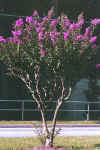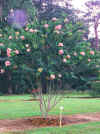The one Question we are asked more than any other question is "How do you Prune
Crape Myrtles"? We
will try and answer that question using text and photos but remember, when all
is said and done, is up to you as the owner of the crape myrtle tree, to prune
it how you prefer. The
1st thing you must know about Crape Myrtles is that they are different from most
other trees and many other shrubs in that they bloom on what's called "New
Wood or New Growth"(most tree's flowers come from the growth they made the
previous year).
Therefore, anything that you can do to make the crape myrtle grow once it
leafs out in the spring will result in more flowers this coming year. Crape
Myrtles thrive on water and fertilizer and if you fertilize once a week or
every 2 weeks you will have more flowers for a longer time than you know what to
do with. 1st- The Miniature Group of
Crape Myrtles Our Patented True
Miniatures grow anywhere from 12" to about 5-6'. Over 20 years ago we
decided that because crape myrtles flower on "new wood" we would breed
the crape myrtles to have a lot of branches or "new wood". Therefore
we kept making genetic crosses to get as many branches as possible ie, the more
branches the more flowers. Look at the photos of our Patented Mini's you find on
this web site. They plants are so "self-branching" they literally
cover themselves in flowers for up to 6 months. The
point being that You don't ever have to Prune the Miniatures. 
Patented Miniature Varieties
'Pink Blush', 'Lafayette', and 'Worlds Fair' cover themselves in buds and
flowers
2nd- Suckers Suckers
are shoots(some people call them watersprouts) that form at the very base of the
plant near where the trunk meets the soil. You can also get suckers if the roots
of the plants are too the the surface of the soil and the roots start sprouting. We
have tried to breed suckers out of Our Patented Miniatures because its not very
attractive to have a beautiful, weeping, 24" miniature hybrid with a 6'
sucker growing out of it. Suckers are
usually seen growing from the base of the Tall and Medium height trees. They are
very soft and you can often break them off with your fingernail. They can
also be removed with your lawn mower or weed eater but try not to damage the
stem of the tree. If you forget to
remove the suckers your crape myrtle tree will begin looking like a crape myrtle
bush. 
Somebody needs to clip off
those 6-8 suckers you see growing down at the base of this crape myrtle tree

These 2 crape myrtle trees are
loaded with suckers that should be removed. Shame!
3rd-
"Whacking" Now we are getting
into the real controversy when pruning crape myrtles. Remember
we told you that crape myrtles bloom on "new growth"? Many
people including some professional landscapers just arbitrarily pick a
height(for example, 6') that they want their tree to be and every spring they
get up there with a hedge trimmer or chain saw or whatever and "whack
off" everything above 6'. The plant
then makes this flush of new growth and covers itself with flowers. Many people
prefer this way and think its the way a crape myrtle should be pruned. If you
have a group of plants in a line along a driveway this method makes the
plants very uniform in height. 
We are looking for a good
photo illustrating a crape myrtle that was "wacked".
In the meantime here is a photo of our company treasurer
4th-Trimming While
there is nothing wrong with method #3 its going out of style in favor of
"natural pruning". In
natural pruning of crape myrtles you leave about 4-8 of the strongest branches
and remove or prune the weaker spindly branches. When
you have removed all the inside weak branches and step backand look at the tree
it almost looks like a tall bonsai tree. This
can best be illustrated with photos: 
Although this tree is over 10
years old notice how only the main stems are left and all the soft suckers, and
weak inside stems have been removed

Notice how the arborist left
the 4 or 5 strongest stems? She may have even wacked a little bit off the tops
here to give them uniformity. Looks very nice

Natural pruning well done
| 
